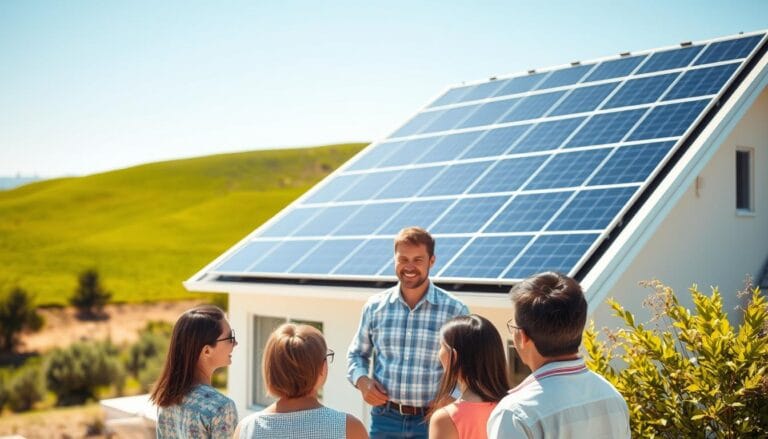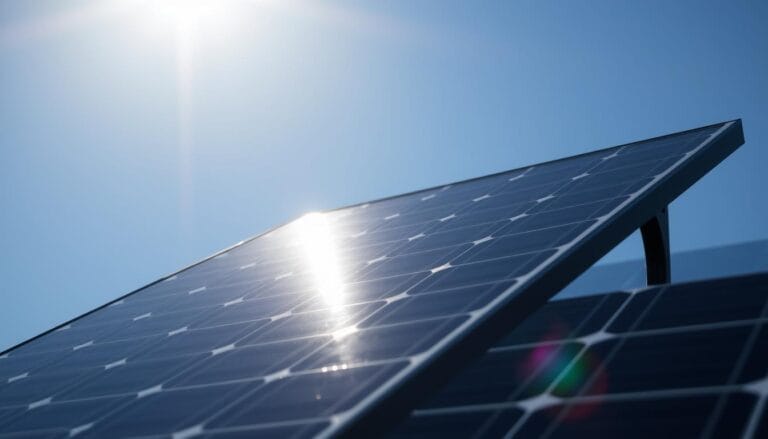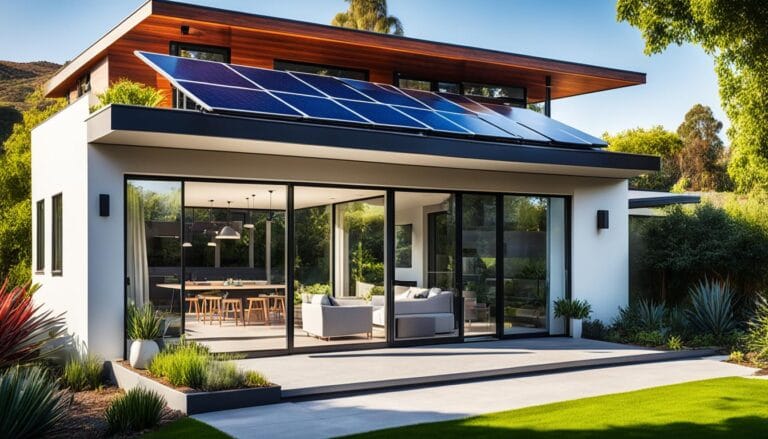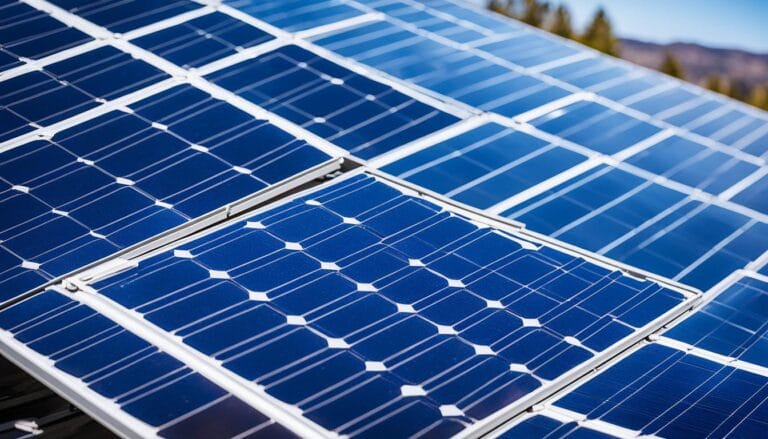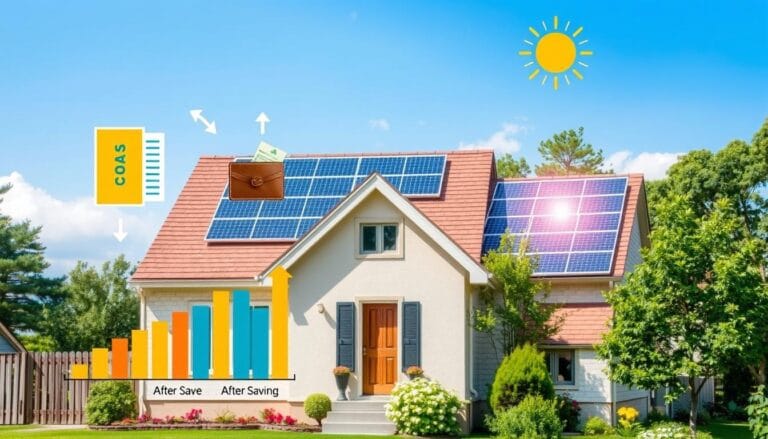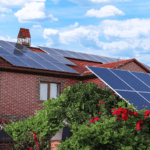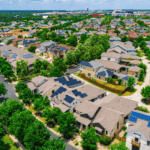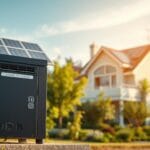This guide explains how an inverter turns DC from solar panels into usable AC power for your home. Think of the unit as the system’s brain: it manages power flow, handles monitoring, and coordinates batteries and the grid.
Two common paths exist: a string inverter that mounts near the service panel and can handle many panels, or microinverters that sit behind each panel and simplify wiring.
Follow the model-specific manual and local code, including NEC 2014/2017 rapid shutdown rules that often require module-level solutions like microinverters or optimizers.
Safety matters: panels produce DC even in low light, so open circuits before work and get a licensed electrician for final terminations when required.
Ahead: we’ll cover planning load and size, picking gear, routing wiring, step-by-step hookups, testing, and when to call a pro. Reliable vendor support and monitoring tools make managing the system much easier over time.
Key Takeaways
- Solar Inverter Installation.
- The inverter converts DC to AC and is the hub for monitoring and energy management.
- Choose between a string inverter or per-panel microinverters based on project needs.
- Follow the manufacturer manual and NEC rapid shutdown rules closely.
- Place the unit in shade, with good ventilation and clearance to extend life.
- DIY tasks are possible, but use a licensed electrician for final connections and inspections.
- Pick suppliers that offer solid technical support and monitoring tools.
What You’ll Learn and Why It Matters for a Seamless Solar Setup
You’ll get a clear roadmap of the process and the decisions that keep projects on time and code-compliant. This short guide explains the key steps and what to watch for so the whole system runs safely and reliably.
Grid-tie and hybrid jobs must follow local laws and utility interconnection rules. Off-grid basics cover connecting a charge controller to the battery, panels to the controller, and battery to the inverter.
Read each manufacturer manual in full. Manuals differ a lot and they often contain code or commissioning requirements you won’t find elsewhere.
“Technical support from experienced providers can speed troubleshooting and prevent costly mistakes.”
- Learn the end-to-end process from load evaluation to code-aligned commissioning.
- Understand gear choices like string vs. module-level electronics for better efficiency and future serviceability.
- Know which tasks need pro help and where DIY is safe; good support shortens downtime and protects power delivery.
Plan Your System: Loads, Size, and Compatibility for U.S. Homes
Begin with a clear tally of what your home uses each day. List major appliances, HVAC runs, and peak loads. This gives a simple baseline for choosing the right size unit in kW.
Estimate home energy needs and right-size your inverter (kW) and system
Many small homes with basic loads start with a 3–5 kW unit. Larger or all-electric homes need more headroom to handle peaks and EV chargers.
Tip: Add 15–25% for future growth so the system meets needs without frequent upgrades.
Match inverter to solar panels, batteries, and monitoring requirements
Verify the inverter matches the solar panel array’s voltage and current window. Check communication links for monitoring and battery charging profiles.
If you plan storage, confirm battery chemistry and BMS compatibility now to avoid costly retrofits later.
Grid-tie vs off-grid vs hybrid: choosing the right system architecture
Pick grid-tie for lower cost and utility interaction, off-grid for full independence, or hybrid for storage and backup flexibility. Local utility rules and permits will shape that choice.
- Tally loads and use a conservative size estimate in kW.
- Match input specs to your panel array and planned battery bank.
- Plan conductor runs to limit voltage drop and keep steady power delivery.
- Budget for disconnects, breakers, and permit fees to stay code-compliant.
Choose Your Inverter: String Inverters vs Microinverters vs Hybrid
Picking the right conversion hardware shapes system performance, maintenance, and future upgrades. This choice affects wiring style, monitoring detail, and how easily you add batteries later.
String units
String units centralize conversion into one wall- or rack-mounted box near the service panel or ground mount. They often support up to around 30 panels, which suits many residential arrays.
Pros: fewer rooftop electronics and simpler servicing.
Micro units
Micro units attach behind each panel for module-level optimization and built-in rapid shutdown. Brands like Enphase are popular for DIY-friendly expansion and detailed per-panel monitoring.
Best for: shaded roofs, phased upgrades, and easy AC wiring on the roof.
Energy storage-ready models
If you plan on batteries, prioritize models that officially support your chosen battery chemistry and BMS. Optimizer-based systems (for example, SolarEdge plus matched optimizers) give module-level benefits while keeping a central converter.
“Confirm compatibility early—mixing unmatched components can cost time and money.”
- Choose string units for centralized, high-capacity setups and ease of service.
- Pick micro units for per-panel performance and modular growth.
- Prioritize storage-ready models if batteries or advanced monitoring are on your roadmap.
Compare real-world efficiency, temperature behavior, warranty terms, and U.S. support when you decide. For a deeper technical walkthrough, see our solar inverter installation guide.
Codes, Safety, and Compliance: NEC Rapid Shutdown and Best Practices
Good safety habits and listed rapid-shutdown hardware reduce risk during maintenance and emergencies. Follow NEC 2014 rules and note NEC 2017 tightened requirements to require shutdown at each module level.
Rapid shutdown solutions include microinverters with built-in module-level shutdown and optimizer-based setups like SolarEdge that meet NEC panel-level rules. If your chosen inverter lacks module-level control, add listed per-panel shutdown devices that the manufacturer approves.
Electrical safety fundamentals
Make sure all circuits are open before work. Use lockout/tagout so neither DC nor AC can energize equipment unexpectedly.
- Always treat panels as live DC sources in any light; cover modules or work during low irradiance.
- Wear PPE, use insulated tools, and follow torque specs on terminals to avoid hot spots.
- Plan listed disconnects on both DC and AC sides, correct breaker sizing, and clear labels for first responders.
- Verify grounding and bonding of racking, enclosures, and metallic components to reduce fault risk.
- Keep conductors in proper raceways with compatible connectors and respect bend radius and fill limits.
“Document module-level electronics and coordinate inspections early to avoid rework and speed approvals.”
Final tip: document serial numbers and locations of components, and confirm rapid shutdown devices are on the inverter manufacturer’s approved list so systems behave predictably during faults or emergencies.
Tools, Materials, and Components You’ll Need for Installation
Start by assembling a compact toolkit and a parts checklist so every wire and connector is ready when needed. This prep step saves time, reduces errors, and improves safety on site.
Essential tools
Bring a drill, insulated screwdrivers, a calibrated multimeter, cable stripper, crimpers, and a torque wrench. Add insulated gloves, safety glasses, and the correct sockets for mounting bolts.
Wiring and connectors
Prepare PV cables and MC4 connectors for rooftop runs, plus DC and AC cable runs sized to limit voltage drop. Keep spare connectors and weatherproof caps on hand.
- Mount brackets to studs; confirm the wall supports the inverter weight per manufacturer specs.
- Stock lugs, ferrules, and properly rated fuses/breakers for each string and AC feed.
- Label each conductor, verify polarity with a multimeter, and follow torque specs on terminals.
Quick tip: make a simple parts checklist before you start so you don’t stop mid-steps looking for a critical cable or connector. Good prep keeps the whole system safer and more reliable.
Solar Inverter Installation: A Step-by-Step How-To
Follow a clear, step-by-step workflow to route wiring, confirm polarity, and bring the system online safely. This short guide covers off-grid and grid-tie wiring basics and the safety checks to run before energizing.
Prepare wiring paths and verify polarity
Step 1: Pre-route conduit and cable paths so runs are neat and accessible. Use a multimeter to verify polarity at DC and AC terminals before landing conductors.
Off-grid connection sequence
Step 2: Connect the charge controller to the battery first. Use properly sized cables and a fuse sized to the controller so the unit can initialize and detect the battery.
Step 3: Connect solar panels to the controller using MC4 connectors. Keep polarity correct and use combiners for series or parallel layouts as needed.
Step 4: Connect the battery to the inverter with short, thick cables and install a listed fuse or breaker per the manual to protect high-current runs.
Grid-tie wiring basics
Step 5: Route PV strings or branch circuits to the DC inputs and land conductors per the wiring diagram. With the main power off, tie the AC output to the home distribution panel.
Final safety checks before energizing
Step 6: Make sure all lugs are torqued to spec and labels are applied at the combiner, disconnects, and panel. Confirm breakers are in the correct positions.
Step 7: Power up methodically—enable DC, then AC—watching status LEDs or the display for expected output and normal operation.
- Step 8: If a fault appears, recheck polarity, voltages, and string layout; verify open-circuit voltages are within the unit’s DC limits under sun.
- Step 9: For hybrid setups, configure battery parameters per the maker’s guidance and confirm charge/discharge behavior once coupling is live.
- Step 10: Document final settings and connections. Save photos or screenshots of stable readings for a baseline during future troubleshooting.
Need more detail? For a deeper technical walkthrough and vendor tips, see our solar inverter installation guide.
Mounting and Location: Heat, Clearance, and Accessibility
Choose a location that balances shade, ventilation, and short cable runs to protect components. A shaded, ventilated wall reduces heat stress from direct sun and helps the unit run near peak energy output.
Pick sturdy support: mount brackets into studs or masonry and verify the wall holds the weight (25–65+ lbs). Keep the unit at a serviceable height so technicians can access terminals and labels safely.
Keep runs short: place the inverter near the service panel or ground-mount structure to limit DC and AC conductor length and reduce voltage drop and heat buildup.
- Select a shaded, ventilated spot that meets clearance specs to avoid thermal derating.
- Use weather-rated enclosures, drip loops, and proper conduit entries to stop water intrusion.
- Maintain clear access to disconnects and space for future growth like a combiner or extra unit.
- Avoid dusty or corrosive air and limit mounting where sunlight will bake electronics during peak sun hours.
Final tip: document the mounting location, clearances, and orientation in your records to ease inspections and future service calls.
Testing, Monitoring, and Troubleshooting for Peak Efficiency
Begin commissioning by powering up carefully and confirming settings match your design. Follow the manual’s sequence: energize DC, check firmware, then enable AC while watching the display for fault codes.
Initial power-up: configuration, firmware, and verifying outputs
On first power-up, confirm firmware is current and the unit reports expected output on the local display or cloud portal.
Use a multimeter to cross-check open-circuit and operating voltages. Mismatches often point to wiring errors, reversed polarity, or misconfigured strings.
Common issues: wiring errors, overvoltage, shorts, or insufficient output
If production is low, inspect panels for shade or soiling. Check connectors, cables, and terminals for loose or damaged points that raise resistance.
Verify ground-fault and arc-fault protections are active. Record any fault codes and consult the maker’s troubleshooting guide or tech support with photos and voltage logs.
Monitoring and maintenance: performance tracking and periodic inspections
Enable monitoring to track trends and get alerts. Compare real-time data to expected models to spot low-efficiency strings or failing modules.
- Tighten lugs and check torque on terminals during scheduled checks.
- Inspect weather seals, connectors, and cable runs for aging or wear.
- Keep records of serial numbers, firmware versions, and config exports to speed support calls.
“Technical support from experienced providers can be invaluable for unique issues.”
- Power up in sequence, verify firmware and output.
- Use a multimeter to isolate wiring faults and confirm electricity parameters.
- Schedule periodic inspections and act on monitoring alerts to maintain efficiency.
When to Call a Pro: Electricians, Permits, and Utility Interconnection
When paperwork, grid rules, or high-voltage work enter the picture, call a licensed pro to keep the job safe and legal.
Why hire a licensed electrician? A pro can run service conductors, make final AC terminations, and tie into the main panel per code. This protects your home and ensures the work meets local inspection standards.
Permits and utility coordination matter. Engage your permitting office early to learn required drawings, labels, and inspections. Contact your utility for interconnection approvals, meter upgrades, or a permission-to-operate (PTO) checklist.
- Ask a contractor to review conductor sizing, overcurrent protection, and grounding plans.
- Get pro guidance for projects that include battery storage, ventilation clearances, or panel upgrades.
- Consider a commissioning service so a professional verifies settings and documents baseline power and performance.
Keep records. Save permit copies, inspection sign-offs, and PTO letters with your system paperwork. These documents protect warranty rights and help future resale.
“When in doubt about code or safety, stop and call a pro—small investments up front can prevent big problems later.”
Conclusion
Finish strong: verify every connection, torque each lug, and save configuration snapshots so a tech can troubleshoot fast.
The correct inverter setup is central to safety and steady energy production. For off-grid rigs, connect solar gear in sequence: charge controller to battery first, then panels to controller, and finally battery to the inverter with short, thick cables.
For grid-tie systems, route strings within DC limits to the unit, then tie the AC output to the service panel per the manual. Prioritize module-level rapid shutdown using microinverters or optimizers to meet NEC and simplify panel-level checks.
Keep records of models, serials, and settings. Lean on vendor support for commissioning and plan for future growth like added panels or energy storage so your system stays reliable for years.








